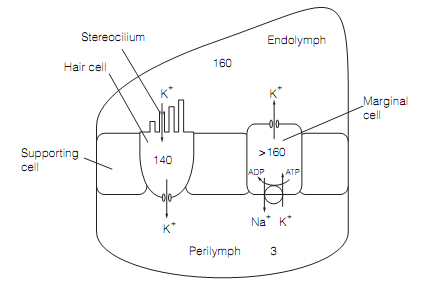Vestibular fluids
The vestibular labyrinth is filled with endolymph that has a potassium concentration of around160 mM and a sodium concentration of about 2 mM, and has a composition alike to intracellular fluid. It is secreted by an expert epithelium, the stria vascularis, lining the outer wall of the cochlear duct, and drains into the venous sinus of dura through the endolymphatic sac. The gap between the bony and membranous labyrinths is filled with a CSF-like fluid, perilymph, secreted by the arterioles of periosteum (the connective tissue layer covering the bone), that drains into the subarachnoid space through the perilymphatic duct. The Active transport by marginal cells maintains the high endolymph potassium concentration as shown in figure below, and outcomes in the endolymph having a potential difference of +80 mV with respect to perilymph. As the resting potential of the hair cell is around -60 mV, the effective potential across its apical border is 140 mV. Therefore there is a large electrochemical gradient favoring facilitated passive diffusion of K+ across the hair cell. This is vital for the hair cell transduction.

Figure: Simplified model of K+ transport in the inner ear. Figures are estimated concentrations of K+ (mM).